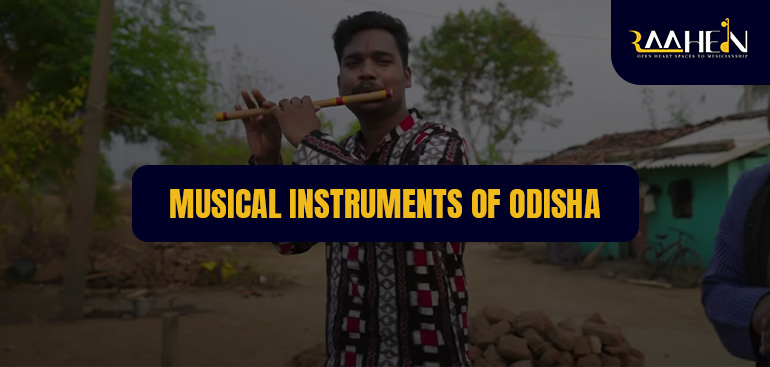Odisha, a state steeped in mythology, heritage, and cultural artistry, carries a centuries-old musical legacy that thrives far beyond the concert halls and classical performances. The musical instruments of Odisha, particularly its folk and tribal instruments, are not merely tools for melody – they are vessels of history, ritual, community, and identity.
Whether accompanying traditional dances, festivals, village storytelling, or spiritual rituals, Odia instruments reflect the region’s immense cultural diversity. And in projects like RAAHEIN Gharana’s recent song “KANJI,” these instruments take center stage, echoing both legacy and living practice.
Let us explore some of the most iconic and culturally significant musical instruments of Odisha that define its native soundscape.
Table of Contents
1. Mardal
The Percussive Pulse A cousin of the pakhawaj, the Mardal is a barrel-shaped wooden drum with two sides, often seen in Odissi dance performances. It produces deep bass on one end and sharper tones on the other. Mardal players often use intricate hand movements to accompany devotional music and folk theatre.
Its rhythms are essential to Odissi music, yet the Mardal also appears in tribal celebrations and rural temple rituals. It is not just a percussion instrument; it embodies tempo, emotional expression, and divine invocation.
2. Mahuri
Odisha’s Traditional Reed Instrument The Mahuri is a double-reed wind instrument, similar in shape to the shehnai but distinct in tone and usage. Played during temple rituals, wedding processions, and rural folk dramas, its vibrant, slightly nasal sound is considered auspicious.
Mahuri players are often part of hereditary musical families who pass down the craft orally. The instrument has an important role in both tribal and non-tribal Odia ceremonies.
3. Dhol
The Festival Drum Large, cylindrical, and double-sided, the Dhol is Odisha’s heart-thumping rhythmic base. It’s played with sticks and slung across the shoulder or waist. The Dhol accompanies a wide variety of events—from street parades and jatras (folk theatre) to harvest festivals.
Dhol beats are simple yet infectious, and in folk songs like “KANJI” by RAAHEIN Gharana, it forms the pulse of the track, bringing celebratory energy and communal joy to the listener.
4. Flute
The Flute holds a special place in Odisha’s folk and tribal music. Traditionally carved from bamboo, its mellow tones evoke nature, spirituality, and romance. It is often played solo during dusk hours, or as a melodic counterpoint to percussive instruments during festivals.
In KANJI, the Flute brings a gentle melodic contrast to heavier drums, evoking a sense of nostalgia and emotional grounding.
5. Ghudka
The Ghudka is a lesser-known but culturally rich instrument of Odisha’s tribal regions. Small and hand-held, it produces a crisp, rattling sound that complements faster rhythms. It’s typically played during tribal dance rituals and folk storytelling performances.
Its inclusion in KANJI offers a textural uniqueness, reinforcing the earthy feel of village life.
6. Ghumra
The Ghumra is a war-drum-like tribal instrument traditionally used in western Odisha, especially among Kalahandi’s tribal communities. It’s worn around the neck and played during dances, often by male performers leaping in rhythmic patterns.
With deep, resonant bass tones, the Ghumra represents courage, celebration, and tribal pride. In KANJI, it adds ceremonial gravity and depth to the track’s festive soundscape.
7. Jhanj
Jhanj are metallic cymbals or clappers used to maintain rhythm in both folk celebrations and devotional gatherings. Their bright, resonant clinking sound adds punctuation and urgency to folk music.
Paired with Dhol and Ghumra in KANJI, Jhanj enhances the communal and spiritual energy of the composition, often echoing in bhajans and street performances.
8. Nissan
The Nissan is a large, rounded war drum played with a wooden mallet. Traditionally used in tribal processions, spiritual rituals, and royal announcements, it has an unmistakable thunderous tone.
In KANJI, the Nissan is used selectively to mark transitions and heighten emotional crescendos, bringing in a powerful sense of movement and cultural memory.
9. Tasha
The Tasha is a semi-spherical kettle drum known for its sharp, ceremonial tones. Commonly heard in processions, village fairs, and festive parades, it’s played with curved sticks and often paired with wind instruments like the Mahuri or Flute.
In KANJI, Tasha’s urgent beats add drama and festive flair, making it one of the driving instruments behind the song’s celebratory rhythm.
10. Nishan
The Tribal War Drum Primarily used by tribal communities, the Nishan is a large war-drum-like instrument made from metal or wood, played with a mallet. It is used in rituals, hunting songs, and in dances where rhythm represents power, strength, and divine protection.
Its sound is often interpreted as a call to gather or a signal of collective action—an ancient form of communication and cultural cohesion.
11. Changu
The Changu is a traditional frame drum used by several tribal communities in southern and western Odisha, including the Kondh, Saura, and Paraja tribes. It is typically made of a circular wooden frame with one side covered by animal skin and played with the hands.
This small, hand-held drum plays a central role in tribal dance forms like Dhemsa, as well as in rituals linked to agriculture, nature worship, and seasonal change.
Its sound is raw, earthy, and rhythmic, often accompanying chants or group dances during village festivals. The Changu is more than a percussion instrument—it’s a cultural artifact that reflects spirituality, land, and tribal identity.
Preserving Odisha’s Musical Ecosystem Through RAAHEIN Gharana
RAAHEIN Gharana’s Rhythmic Roots series is a testament to the power of rediscovering and re-recording India’s lesser-heard instruments. In their recent song “KANJI,” native Odia instruments like Mahuri, Dhol, Mardal and Gini are played by regional musicians from Kalahandi, echoing the richness of local tradition.
KANJI is more than an Odia folk song – it’s a living archive of sound, story, and cultural expression. The song brings together 12 artists – 9 regional and 3 contemporary — blending the raw energy of grassroots music with fresh, modern perspectives.
Watch the Tradition Come Alive
Watch the full video of “KANJI” on YouTube and explore more folk-based tracks by RAAHEIN Gharana on Spotify, Apple Music, Gaana and more.
The musical instruments of Odisha tell stories without words. They are shaped by ritual, land, and people. As India looks forward, initiatives like RAAHEIN Gharana ensure that we don’t leave behind the very sounds that shaped our roots.
Let us listen. Let us remember. Let us celebrate.

